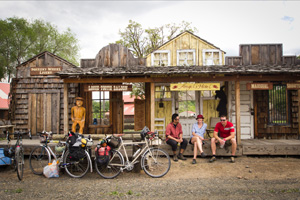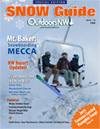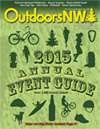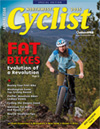Bike Advocacy in Washington and Oregon

How Vision and Hard Work are Shaping Cycling
By Rebecca Agiewich
Photo at right: Bicycle tourists find the amenities they need along the Old West Scenic Bikeway in Oregon. Photo courtesy of The Path Less Pedaled
Cyclists who live in the Northwest think it’s a great place for two-wheeled adventures. The League of American Bicyclists agrees. In 2014, they named Washington the No. 1 state for biking (for the second year in the row); Oregon ranked fifth.
Yes, our corner of the country is stunningly beautiful and practically made for biking. But, it isn’t just our jaw-dropping scenery and diverse landscape that has won us this recognition.
It’s vision and plain old-fashioned hard work.
A slew of advocates in both states are working their (spandex-padded) butts off to make sure that cyclists can bike safely and comfortably in their home cities and beyond. These advocates work in government and in bike shops. They volunteer for bike clubs, grassroots organizations and neighborhood-based groups. You might never know their names, but you’ll definitely appreciate the results of their hard work.
From protected bike lanes to neighborhood greenways; from bike-friendly businesses to bike-aware mayors; here are just a few of the recent improvements making biking safer, more accessible, and more fun in Washington and Oregon.
Pronto Cycle Share in Seattle
In October 2014, Seattle unveiled Pronto—the first bike share program in the Northwest. Pronto launched with 500 distinctive green bikes at 50 docking stations around Seattle.
As of December 2014, Pronto reported that enthusiastic users had ridden its bikes over 39,000 miles—or six times around the moon. And, that period included one of the wettest Octobers on record!
The program germinated years ago with a group called the King County Bike Share Partnership. This group evolved into Puget Sound Bike Share (now Pronto Cycle Share), which incorporated as a non-profit and made Pronto a reality with the help of many local partners and donors.
For Seattleites who might want to give Pronto a try, the Cascade Bicycle Club offers a class called “Pronto Street Skills” to teach the basics of urban biking and bike commuting.
Neighborhood Greenways
Maybe you’ve stumbled upon one of these greenways by accident (like I have in Seattle).
You see a sign with a bike symbol on it that says “Neighborhood Greenway,” and you follow it. What you find is a quiet, low-traffic street with speed bumps, helpful signs, crosswalks for bicycles, and sharrows. In other words, a safer route home than you might have otherwise taken.
Neighborhood greenways—which create safer streets for cyclists and pedestrians—are a huge focus for the cycling communities in both Seattle and Portland.
Alex Reed, founder of the Portland advocacy group BikeLoudPDX, says that while Portland helped pioneer the neighborhood greenway concept in the ’80s, it now has a lot of older greenways that need updating. That’s one of the projects BikeLoudPDX is focusing on, says Reed.
Similarly, the Bicycle Transportation Alliance—a statewide advocacy group located in Portland—is also focusing on improved neighborhood greenways. BTA’s Communications Manager, Hatham Al-Shabibi, says that the group is especially interested in expanding greenways in east Portland so that they connect to other parts of town.
Seattle, meanwhile, has its own advocacy group dedicated to greenways. Founded in 2011, Seattle Neighborhood Greenways was a crucial player in getting 245 miles of greenways into Seattle’s updated bike master plan.
Cathy Tuttle, the Greenways’ executive director, explains that the Greenways group is composed of 20 smaller, “hyper-local” groups that advocate for their own neighborhoods.
“The City of Seattle has invested about $16 million in safe street improvements based on our recommendations,” she says. “So we’re having a very direct influence. The model is working well.”
Master Plan; Protected Lanes
Cycling advocates around Seattle have lots of respect for Seattle Mayor Ed Murray and the new bicycle master plan that he (aided by many agencies and volunteers) helped to pass in spring 2014.
The plan includes 475 miles of new bike infrastructure, which was “huge,” says Anne-Marije Rook, Communications Director for Cascade Bicycle Club.
The master plan “kicked off with a protected bike lane in the heart of downtown, which is a pretty bold move on the city’s part,” says Tom Fucoloro, the publisher of the Seattle Bike Blog.
Fucoloro is referring to the two-way protected bike lane on Second Avenue, where cyclists are physically separated from traffic by either bollards or parked cars, and have bike-only signals that help protect them from turning vehicles.
Completed last September, the protected bike lane has been a success.
“Use of Second Avenue by cyclists tripled after the protected route went in,” says Jeff Aken, Advocacy Director for Cascade Bicycle Club. It’s also garnered national attention. PeopleForBikes named it No. 2 in its list of top 10 bike lanes for 2014. Not far behind were Seattle’s Broadway protected bike lane at No. 6 and Portland’s SW Multnomah Boulevard at No. 7. (See “Seattle, Portland Bike Lanes” story on page 28.)
Oregon’s Bike Tourism Boom
Oregon has become a leader in bike tourism, thanks in part to the Oregon Scenic Bikeways program that was masterminded by Cycle Oregon, Oregon Parks and Recreation, Travel Oregon and ODOT.
A recent study done by Travel Oregon—the state’s destination marketing organization—showed that bike tourism brought in $400 million to Oregon in 2012. To encourage this trend, Travel Oregon has recently launched a state Bike Friendly Business recognition program that trains businesses along the Scenic Bikeways (and elsewhere) to be more bike-friendly.
To earn the “Oregon Bike Friendly” recognition, businesses must meet certain requirements. Bike-friendly lodging, for example, must let cyclists bring their bikes into their rooms or provide a secure, dry place to park them. Designated bike-friendly campgrounds must allow cyclists to stay there regardless of a reservation.
Pedal into a rural town like John Day, Ore.—a stop along the Old West Scenic Bikeway—and you’ll find more than 50 recognized bike-friendly businesses. This means you’ll be able to find a place to change a tire, fill your water bottle and use the bathroom. Best of all, you’ll experience a more welcoming vibe and better customer service than you might in other, less bike-aware areas.
“The real bottom line,” says Alex Phillips, Bicycle Recreation Coordinator for Oregon Parks and Recreation, “is a certain friendliness and understanding that cyclists are tourists just like other tourists.”
Resources
Pronto Cycle Share: www.prontocycleshare.com
Seattle Neighborhood Greenways: www.seattlegreenways.org
Seattle Bike Master Plan: www.seattle.gov/transportation/bikemaster.htm
PeopleForBikes: America’s 10 Best New Bike Lanes of 2014 www.peopleforbikes.org/blog/entry/americas-10-best-new-bike-lanes-of-2014
Bike-friendly businesses in Oregon: www.rideoregonride.com/resources/bike-friendly-businesses
Oregon’s designated scenic bikeways:
www.oregon.gov/oprd/BIKE/Pages/index.aspx
www.goldtravelblog.com/2012/oregons-designated-scenic-bikeways
Seattle writer Rebecca Agiewich is a regular contributor to OutdoorsNW. Even though she has ridden bikes around the world from Patagonia to Portugal, Rebecca still thinks the Northwest is one of the best places to ride.



